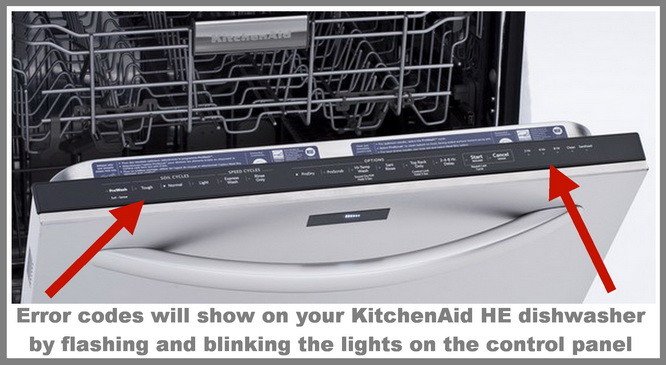
In the world of dishwashers, especially those from reliable brands like Kitchenaid, error codes are like secret messages from the appliance. They’re telling you that something isn’t quite right. The “HE” code is one of these messages, signaling a problem with the heating element in your dishwasher. If you’re scratching your head wondering what a heating element is, think of it as the part of the dishwasher responsible for heating the water. Without it, your dishes won’t get the high temperatures they need for proper cleaning. Let’s dive deeper into why this code appears and what you can do about it.
Understanding the “HE” Error Code
So, what’s the real story behind this “HE” code? The code essentially means that your dishwasher’s heating element isn’t doing its job. The heating element is crucial because it raises the water temperature in the dishwasher, making sure your dishes come out squeaky clean and sanitized. It’s a bit like trying to wash your hands in cold water—you can do it, but it’s not nearly as effective as using warm water.
When your Kitchenaid dishwasher displays this error code, it’s indicating that either the heating element is malfunctioning or the temperature sensor isn’t working correctly. In simple terms, the “HE” error is a gentle nudge from your dishwasher, telling you that it’s struggling to heat the water to the necessary temperature. It’s like your dishwasher is whispering, “I need a little help here!”
You might be wondering, “Is this a big deal?” Well, it can be. If your dishwasher can’t heat the water, it can’t effectively dissolve detergent or kill germs. So, fixing this issue is pretty important if you want to ensure your dishes are clean and germ-free.
Common Causes of the “HE” Error
Now, you’re probably asking, “What causes this error to pop up?” There are a few common reasons. First, it could be a faulty heating element. Just like a light bulb that doesn’t light up, a heating element can burn out over time. If it’s broken, it won’t heat the water, leading to the dreaded “HE” error.
Another possible cause is a problem with the wiring or connections to the heating element. If the wires are loose or damaged, they might not deliver the power needed for the element to heat up. Think of it like a broken extension cord that doesn’t power your lamp, leaving you in the dark.
Finally, there might be an issue with the dishwasher’s thermostat or temperature sensor. If the sensor fails, it might not detect the water temperature accurately, causing the system to think the water isn’t heating up even if it is. This can be a bit like having a thermometer that always reads the wrong temperature.
How to Fix the “HE” Error
So, what do you do about it? First, if you’re comfortable with a bit of DIY, you can try checking the heating element for any visible damage. Look for signs like obvious breaks or burn marks. If it appears damaged, replacing the heating element might be the way to go. It’s not unlike changing a broken bulb—just make sure the power is off before you start!
If the heating element looks okay, consider examining the wiring and connections. Sometimes, tightening a loose wire can fix the problem. It’s a delicate task, so if you’re not sure, calling in a professional might be the best bet.
Lastly, if the problem persists, it could be time to check the thermostat or temperature sensor. This gets a bit more technical, so it’s often wise to consult a technician. They can test the components with specialized tools, ensuring that every part of the dishwasher works in harmony.
Preventing Future Error Codes
While fixing the issue is important, preventing it from happening again is even better. Regular maintenance can keep your dishwasher running smoothly. Consider cleaning the dishwasher’s filter and spray arms regularly to prevent clogs, and ensure that you’re using the right type of detergent.
Another tip is to run the dishwasher at least once a week even if it’s not full. This helps keep the parts moving and prevents them from sticking or seizing up. It’s like taking your car for a spin once in a while even if you’re not going anywhere important.
Finally, being mindful of how you load the dishwasher can make a big difference. Overloading it or blocking the heating element with large items can prevent effective cleaning, potentially leading to errors. So, give your dishwasher some breathing room and let it do its thing.
When to Call a Professional
Even with the best intentions and a can-do attitude, there are times when it’s best to call in a professional. If you’ve tried troubleshooting the issue and it persists, or if you feel out of your depth, don’t hesitate to seek help. Professional technicians have the expertise and tools needed to diagnose and fix complex problems.
It’s important to remember that dishwashers are sophisticated machines with many interconnected parts. While some issues are easy to fix, others can be more complicated. So, if you’re unsure, reaching out to a professional can save you time and prevent further damage.
In the end, understanding your Kitchenaid dishwasher’s “HE” error code is all about gaining peace of mind. By knowing what it means and how to resolve it, you can keep your dishwasher running smoothly and your dishes sparkling clean.